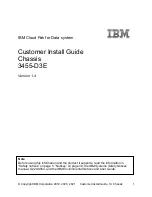
Using iLO 2 93
Shared Remote Console
Shared Remote Console is an iLO 2 feature that allows the connection of up to four sessions on the same
on the same server. This feature does not replace the Acquire feature described in "Acquiring the Remote
console (on page
96
)" or allow full-access clients (read/write) to control power. Shared Remote Console
does not support passing server host designation to another user or a failed user connection to reconnect
after failure. You must restart the remote console session to allow user access after failure.
Shared Remote Console is a licensed feature available with the purchase of optional licenses. For more
information, see "Licensing (on page
26
)".
Shared Remote Console and Forced Switch mode are disabled by default. You must enable and configure
these features through the browser, SMASH CLI (OEM), or RIBCL. All console sessions are encrypted by
authenticating the client first, and then the session leader decides whether to allow the new connection.
The first user to initiate a Remote Console session connects to the server normally and is designated as the
session leader (session host.) Any subsequent user requesting Remote Console access initiates an access
request, requesting a satellite client connection, calling the session leader. A pop-up for each satellite
client request appears on the session leader's desktop, identifying the requester's user name and DNS
name (if available) or IP address.
Session hosts have the option to grant or deny access. A list of users and session host names appears
within the remote console browser frame. Satellite client sessions terminate when the session host is
terminated.
Shared sessions do not operate well with the Console Capture and replay features of iLO 2. If a satellite
session is viewing a captured session, during the playback time, the satellite session will not receive
session leader control messages. If the session host starts to view captured video data during a shared
session, the video is displayed on all satellite Remote Console sessions.
Using Console Capture
Console Capture is a Remote Console feature that enables you to record and replay a video stream of
events such as booting, ASR events, and sensed operating system faults. You can also manually start and
stop the recording of console video. Console Capture is only available through the iLO 2 user interface
and cannot be accessed through XML scripting or the CLP. Console Capture is a licensed feature
available with the purchase of optional licenses. For more information, see "Licensing (on page
26
)".
A buffer area is set aside in the management processor to store captured video data. This buffer area is
shared with the firmware update buffer, so any information captured is lost when you start the firmware
update process. You cannot capture video data during the firmware update process.
Buffer space is limited. Only one of each type of event is stored in the buffer area at a time. You can
transfer captured data buffers to a client running the IRC for replay. You can also configure iLO 2 to
automatically send captured video data to a web server on the same network as the iLO 2 when an event
occurs. The web server must accept POST-method data transfers. You can select Boot buffer only, Fault
buffer, or combine them both as one large buffer to have more room to capture Linux boot sequences.
Exported buffer data is given a unique name to easily identify the data for playback. Playback requires a
licensed iLO 2 on the network. Some operating systems (such as Linux) can fill the buffer quickly. If you
leave the system console in text mode, it helps maximize the amount of information captured. Also,
closing or reducing the number of active graphical console elements helps optimize internal buffer space.
You can manually capture video of the server console using the IRC Record feature. All manually captured
data is stored in a local file on the client for later playback.











































